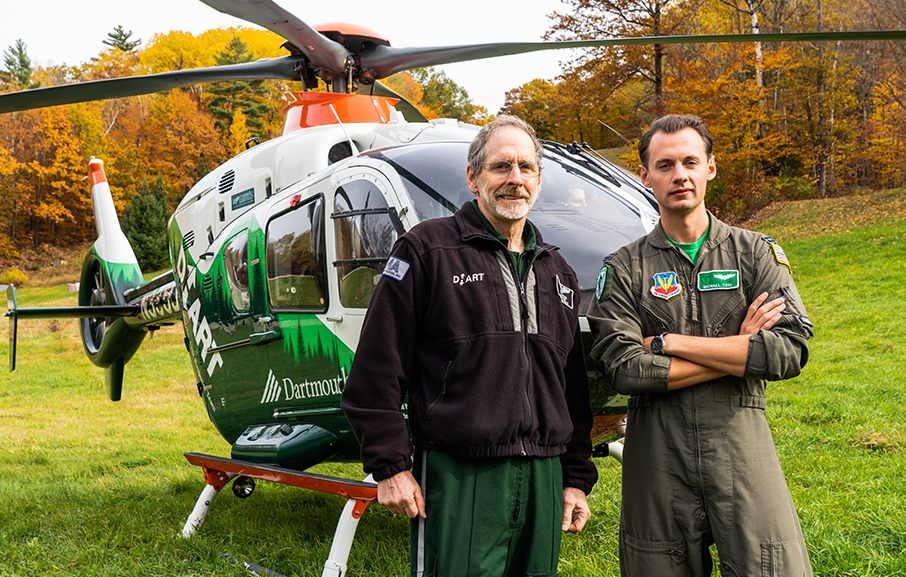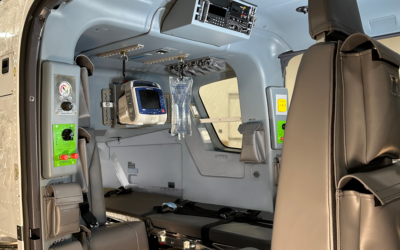Making the military-to-civilian transition
March 5, 2020
Source: Vertical Magazine
“If I need another helicopter pilot, I’ll just go down to Bourbon Street and pull one out of the gutter.”
Incredibly enough, this oft-quoted commentary on the perceived disposable nature of helicopter pilots was attributed to a former CEO at one of North America’s largest commercial helicopter operators. While I can’t speak to the veracity of the quote, it perfectly epitomizes the pervasive attitude about pilots that has left our industry scrambling.
As is evident from a growing number of unfilled job openings, the pilot shortage is no longer hypothetical, nor is the helicopter industry immune. While the reasons are clear — the retirement of Vietnam-era pilots, airline hiring, a flight-hour-constrained military, and stagnant civilian pilot production — the solutions are not.
Even if the civilian pilot training pipeline were to be properly promoted, incentivized, and rapidly spooled up, it would still take the better part of five years until the impact was felt. One of the few options the helicopter industry has now is to attract more military pilots, but here it’s losing to the airlines, and losing badly.
As a military aviator rapidly approaching the end of my service commitment, I was given a chance by Vertical Valor to take a firsthand look at the military-to-civilian pilot transition. I would start by going through the various hiring wickets, an interview, then in-house training and qualification on the aircraft of choice, ultimately culminating in a week on the job.
My goal was not only to provide a template for pilots looking to make the switch — including those who may still be on the fence — but also to examine what the industry can do better to both attract and retain military pilots.
The job search
In an effort to keep this undertaking as realistic as possible, I looked at jobs I’d not only be interested in, but also for which I would theoretically be competitive. With a background in U.S. Air Force combat search-and-rescue (CSAR) and a desire to work in a specific location, I found the helicopter air ambulance (HAA) industry to be a natural fit.
My research led me to Metro Aviation, considered by many to be the benchmark when it comes to the HAA industry in the United States. Founded in 1982 by Mike Stanberry, it is known for a culture that embraces safety, innovation, customer service, and — most importantly — taking care of its people. With a focus on traditional hospital-based programs, Metro is well incentivized to provide a quality product when it comes to aircraft and pilots.
As for choosing a base, that was easy (and quite frankly the cart came before the horse on this one). Having grown up in rural New England, I’ve long been familiar with the Dartmouth Hitchcock Aerial Response Team — “DHART” for short. Painted in a distinctive green, white, and orange livery, its Airbus EC135 P2+ helicopters offer a stunning contrast to the New England scenery. The program also has a stellar reputation, both on a local and national level.
Having Valor pitch my story idea to Metro was admittedly cheating a bit when it came to getting an “interview,” but the value of networking still can’t be overstated. While the military hiring process is very structured in nature, getting a job in the civilian industry is often more about personality, fit, and commitment to a future employer or base. It’s never too early to start this process, and I recommend compiling a list of prospective employers years out from separating. Pay a visit every so often while you’re on leave, network on social media, and stay in touch with your contacts as you approach your separation date.
Of course, you also need to be qualified for your next job at the time of separation. Unfortunately, in our industry “being qualified” means meeting minimum hour requirements, which is easier said than done in today’s military.
My interview with Metro Aviation took place at the company’s headquarters in Shreveport, Louisiana, in the presence of director of training John McClure, head of human resources (HR) Rebecca Stinson, and chief pilot Brian Bihler. In an effort to pass on any tips, techniques, or mistakes on my part, I told them to pull no punches. The experience was remarkably authentic and at times I found myself sweating a bit, forgetting it wasn’t an actual job interview.
While I’m clearly an advocate for the value of military training and experience, I would also strongly caution pilots making the switch to the civilian world: When the time comes, leave your attitude and preconceived notions at the door. At the time of hiring, there’s a good possibility your civilian counterparts will be far more qualified for the job. Due to their greater flight experience on the types of helicopters flown outside the military, the likelihood exists they’ll also be better on the controls. Stepping into your interview and ultimately a new career, be humble and know that while your airmanship, past experiences, and training can ultimately help set you apart, you’re still applying for an entirely different job.
I was surprised to find that the interview process at Metro didn’t stop with a verbal interview; there was also a written test and an “interview sim.” The written test covered subjects including airspace, instrument flight rules (IFR), and Federal Aviation Regulations part 135. While I “passed,” my results were a bit lackluster and could have been a red flag. This leads to another critical piece of advice: Unlike the military, don’t show up expecting to be spoon-fed or started from square one (and take the time before your interview to brush up on the regs and other information pertinent to the job).
Fortunately I still had an opportunity to redeem myself in the interview sim. Conducted in one of Metro’s phenomenal level D full-motion flight simulators, the emphasis was on general airmanship, rather than on the specific aircraft or HAA operations. I followed along as my instructor and experienced check airman Scott Michaelson helped me with startup, before having me pick up for some hover work and a few laps around the pattern. This was followed by a scene call and rooftop landing, all immaculately modeled with stunning visuals.
While this all sounds rather vanilla, let’s just say you’ll face various challenges in the sim, from unforecast weather to unpredictable landing zone conditions during the sortie. I’ll remain vague in an effort to not give away all of Metro’s secrets, but expect these to test your judgment and aeronautical decision making.
I was told I had done well and presumably would have passed. Although unlike the written test, I felt slightly more confident in my performance — not due to any particular skill in the sim, but rather because I had met my single quantitative metric of success established over years in military simulators: avoiding the proverbial “red screen of death.” Either way, I walked away with a notional job offer from chief pilot Bihler.
Basic indoc
Upon receiving and accepting my “offer” at Metro, it was time to attend basic indoc (BI). The course is typically two weeks long, although I was on a slightly abbreviated schedule due to other commitments. The first week primarily focuses on learning company procedures and operations specifications (ops specs), while the second week involves ground school and sim training on the respective aircraft (in my case, the EC135 P1/P2+). Having just come from a nearly two-month-long instructor upgrade, this was markedly shorter than the military transition courses I’m accustomed to.
As with any new hire, I was put in touch with pilot training coordinator Rachel Corpier to make travel arrangements. I mention this because the process was seamless and, oddly enough, one of the highlights of the whole process. Anyone familiar with Defense Travel System or government travel can surely appreciate why! Of course, with any good news comes a bit of bad news — specifically, about a week’s worth of computerized training to be completed prior to the conclusion of BI. (While I had asked for the “full experience,” this is one area where I invoked some editorial privilege and skipped a bit of the courseware.)
Showing up in the hotel lobby to catch the shuttle to Metro, I met my BI classmates. Our class was large by Metro standards and quite diverse. There were a few newcomers to HAA, most transitioning from flying tours or offshore in the Gulf of Mexico. We also had several members of the class either returning to the HAA industry or transitioning to Metro from other HAA operators. Tellingly, there was no one transitioning directly from the military.
The first day of BI consisted largely of HR paperwork with briefings on pay and benefits. While Metro acknowledges that it doesn’t offer the highest salaries in the industry, it does have an industry-leading benefits package. Noteworthy for veterans who already have medical coverage is the $5,000 credit Metro offers if you elect to keep your existing coverage. Also worth keeping in mind is the prospect of overtime — never guaranteed, but usually not lacking given the current shortage of pilots.
After wrapping up with HR, it was time to become acquainted with Metro’s general operations manual and Complete Flight, an app that simplifies much of the paperwork associated with part 135 flight operations. Our guide for most of this was field training manager Ann Lowell, who was wonderful and patient with us as we fumbled along on our iPads. Interspersed throughout the week were several talks from Metro’s senior leadership, including Mike Stanberry and his son Todd. It was clear how much pride they took in their corporate culture and being a family-run business, especially in an industry now dominated by private equity.
Classroom wrapped on Friday and while everyone else had the weekend to catch up, my week was about to get even busier. Due to my abbreviated timeline, I asked to condense a week of ground school and sims into two days. While this was fairly aggressive, I was able to start preparing earlier in the week with a review of the pilot operating handbook and various study guides. In addition to the EC135 being fairly straightforward, with no defensive systems, weapons, or tactics to memorize, it was markedly easier to get the basics down.
With a fair amount of SAR and night vision goggle (NVG) experience under my belt, I was able to emphasize basic checklist procedures and emergency procedures (EPs) as we moved into the sim. While the transition from a multi-crew cockpit to single-pilot operations was significant, concurrently going from the best technology the late ’80s had to offer (our Sikorsky HH-60G Pave Hawk) to a fully coupled autopilot and all-glass cockpit was a game changer. Metro’s IFR-equipped 135s were remarkably intuitive, and after gradually learning to trust the autopilot, I quickly settled into single-pilot operations.
Because of my abbreviated timeline and not technically being an employee, I wasn’t able to complete an “official” part 135 checkride upon completion of BI. I did, however, ask to be put through a simulated one, which like any military check flight started with a robust general knowledge session before moving into the sim. The flight profile was similar to the weekend’s previous sims, with a scene call, rooftop hospital pad landing, and copious amounts of EPs in between. Having lived up to my previous metric of success — avoiding the red screen of death — I was “checkride” complete and off to New Hampshire for a week with DHART.
In the field
As you can likely tell from the pictures, the timing of my week spent at DHART was no accident — there are few things more spectacular than fall in the Green and White mountains. DHART’s main base is nestled between these two mountain ranges near the scenic Dartmouth campus in Hanover, New Hampshire. Started to provide advanced level emergency medical care to rural New England, DHART has grown under its current leadership to include two additional bases in Manchester, New Hampshire, and Burlington, Vermont, covering the whole of both states.
Prior to handing them the reins solo, Metro requires its pilots to undergo extensive on-the-job training at their respective bases. For my familiarization, I was scheduled with DHART chief pilot Paul Austin and base lead Doug Moore, rotating between the two New Hampshire bases. Coming from significantly different backgrounds, both with an immense amount of experience, they were able to provide two unique perspectives on the military-to-civilian transition: Moore as a former Air Force CSAR/special operations pilot, and Austin as a civilian-trained pilot who has seen a number of military aviators make the transition at DHART.
Both identified systems knowledge, IFR proficiency, and the ability to manage a crew along with multiple radios as common strengths of military aviators. Those who struggled to make the transition, they said, were unable to adapt from a “mission first,” aircraft-focused mentality to serving a customer. While the pilot-in-command is still the final authority as to the operation of an aircraft, regularly ordering civilians around, as if they’re in the military, is likely to end poorly. Same for aggressively pushing aircraft or weather limits to accomplish a flight.
Although there are numerous differences between the military and civil aviation worlds, there are also remarkable similarities, particularly in HAA. Getting a tone at DHART prompted the same kind of rush associated with a combat rescue or civil SAR mission. A late-night scene call in the White Mountains or IFR hospital approach, with weather at minimums, and prospectively single pilot, demands no less attention or skill. Of course, there was inevitably downtime, too, and the ensuing banter between a close-knit group of people doing a job they love.
The crew dynamic was actually the biggest surprise of the transition for me and also the most enjoyable. I had heard horror stories about civilian med crews: their disinterest in all aviation matters, reluctance to fly, or just general lack of professionalism. This couldn’t have been further from the truth at DHART.
From the start of shift briefing to hour 14 of the duty day, the Dartmouth Hitchcock clinicians were always engaged and an integral part of the crew. The crew resource management was exactly what I had grown accustomed to over years flying crewed aircraft, with the med crew running checklists, clearing the tail, and everything in between. While the transition from a multi-crew cockpit to single-pilot operations is certainly a significant one, having an engaged med crew helps immensely.
Closing thoughts
The civil helicopter industry is currently perceived by a majority of U.S. military aviators as being underpaid, risky, and — due to minimum flight hour requirements — often unattainable even if they wanted to make the switch. I take a bit of liberty in saying “a majority” rather than “many,” but this is supported by fairly compelling data when it comes to the volume of pilots transitioning to the airlines from the military, not to mention overwhelming anecdotal evidence received through day-to-day interactions and social media.
Even as I sat writing this article on a flight back from Europe, I started speaking with one of my neighbors — who, ironically enough, was a U.S. Navy helicopter pilot nearing his retirement date. When I asked him about his future plans, there was discussion of the airlines, staying in the military past 20, a desk job, and even going back to school, but no mention of continuing in the civilian sector as a helicopter pilot. When queried further as to why, he gave me a perplexed look and a response, bordering on incredulous, as to why he’d even consider it in light of all of the negatives I’ve previously alluded to.
Like most readers of Valor, I’m passionate about helicopters, and so are many of the folks I work with in the military. It’s alarming to see that level of enthusiasm, training, and experience draining away from the industry at such a rate. Despite its drawbacks, civilian employment as a helicopter pilot also offers a number of positives, including challenging flying and, in the HAA sector at least, the possibility of being home every night. For those of us who joined the armed services to be part of something bigger than ourselves, the helicopter industry also affords many opportunities to continue serving the community, whether in HAA, firefighting, or even utility work.
All of this begs the question: After an experience this in-depth, would I actually take a job in the industry? Absolutely, especially somewhere with a culture like that of DHART and Metro. But given that I volunteered my personal “vacation” time for this project, I may be an outlier — and even for me, the prospect of a nearly 50 percent pay cut from active military service gives me some pause (see “Culture, Salary and Benefits,” p.61).
Solutions to the helicopter industry’s pilot shortage are no secret, and attracting more military aviators is one of many. Unfortunately, implementing those solutions will first require the industry to acknowledge several endemic problems. Market forces are finally driving some changes, but irrespective of the current shortage or how long it lasts, these lessons should be taken to heart by an industry that often forgets human capital is the most important kind. If we continue to treat pilots like they can be pulled out of any gutter, we’ll continue to see a mass exodus of talent on both the military and the civilian side.
The views expressed in this article are those of the author and do not reflect the official policy or position of the United States Air Force, Air National Guard, Department of Defense, or the U.S. government.
Stay Updated with Metro
Metro Achieves AS9100 Certification
Metro Achieves AS9100 Certification APRIL 23, 2025 Metro is proud to announce that it has officially achieved AS9100 certification, marking a significant milestone in the company’s ongoing commitment to quality, safety, and continuous improvement in the aviation...
Metro Officially Recognized as a DoD SkillBridge Employer
Metro OFFICIALLY RECOGNIZED AS A DOD SKILLBRIDGE EMPLOYER APRIL 17, 2025 Metro Aviation proudly recognizes the talent, discipline, and strong work ethic that military members bring to its organization. With over 40% of its workforce made up of Veterans, the company...
Metro Aviation Unveils Upgraded H135 Air Medical Interior
Metro Unveils Upgraded H135 Air Medical Interior March 12, 2025 Metro Aviation is introducing its latest air medical interior for the H135, featuring notable upgrades while retaining popular elements from the previous design. “We developed this interior based on...
Download Brochure
Metro Aviation is constantly growing our capabilities and expanding our reach. Metro holds more than 30 Supplemental type Certificates (STC) and completes about 35 aircraft each year for U.S. customers anf global clients.





